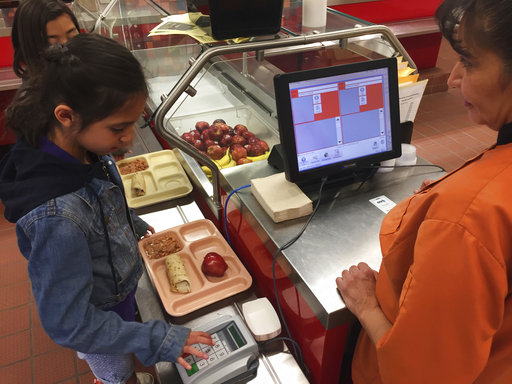
In this Thursday, May 4, 2017 photo, third grader Elliana Vigil punches in his student identification meal to pay for a meal at Gonzales Community School in Santa Fe, N.M. (AP Photo/Morgan Lee)
SANTA FE, N.M. — Teaching assistant Kelvin Holt watched as a preschool student fell to the back of a cafeteria line during breakfast in Killeen, Texas, as if trying to hide.
“The cash register woman says to this 4-year-old girl, verbatim, ‘You have no money,'” said Holt, describing the incident last year.
A milk carton was taken away, and the girl’s food was dumped in the trash. “She did not protest, other than to walk away in tears.”
Holt has joined a chorus of outrage against lunchroom practices that can humiliate children as public school districts across the United States rethink how they cope with unpaid student lunch debts.
The U.S. Agriculture Department is requiring districts to adopt policies this month for addressing meal debts and to inform parents at the start of the academic year.
The agency is not specifically barring most of the embarrassing tactics, such as serving cheap sandwiches in place of hot meals or sending students home with conspicuous debt reminders, such as hand stamps. But it is encouraging schools to work more closely with parents to address delinquent accounts and ensure children don’t go hungry.
“Rather than a hand stamp on a kid to say, ‘I need lunch money,’ send an email or a text message to the parent,” said Tina Namian, who oversees the federal agency’s school meals policy branch.
Meanwhile, some states are taking matters into their own hands, with New Mexico this year becoming the first to outlaw school meal shaming and several others weighing similar laws.
Free and reduced-price meals funded by the Agriculture Department’s National School Lunch Program shield the nation’s poorest children from so-called lunch shaming. Kids can eat for free if a family of four earns less than about $32,000 a year or at a discount if earnings are under $45,000.
It’s households with slightly higher incomes that are more likely to struggle, experts on poverty and nutrition say.
Children often bear the brunt of unpaid meal accounts. A 2014 federal report found 39 percent of districts nationwide hand out cheap alternative meals with no nutritional requirements and up to 6 percent refuse to serve students with no money.
The debate over debts and child nutrition has spilled into state legislatures and reached Capitol Hill, as child advocacy groups question whether schools should be allowed to single out, in any way, a child whose family has not paid for meals.
“There’s no limit to the bad behavior a school can have. They just have to put it in writing,” said Jennifer Ramo, executive director of New Mexico Appleseed, an advocacy group on poverty issues. “We live in a credit society. I think schools should handle debt like everybody else does: You don’t take away food from children. You feed them and you settle the bill later.”
Spurred by Appleseed and others, New Mexico in April passed its anti-meal-shaming law, which directs schools to work directly with parents to address payments and requires that children get a healthy, balanced meal regardless of whether debts are paid on time.
Elsewhere, the California Senate in May unanimously approved a bill that prevents schools from denying lunch if a parent or guardian has not paid.
Thresa Thomas, a Los Angeles Unified School District food service worker for students with severe physical and learning disabilities, grinds up complimentary cheese sandwiches in a food processor to serve through feeding tubes to students who don’t bring lunch and whose parents have not paid.
“They’re not able to complain too much,” she said. “We should give them all the same food, and we should collect the money as much as possible.”
Texas recently adopted a temporary grace period for students to keep eating cafeteria food while debt payments are negotiated with parents.
At the federal level, language has been proposed for next year’s House appropriations bill that would set minimum standards to protect children from public embarrassment and leave them out of payment discussions.
New Mexico’s Hunger-Free Students’ Bill of Rights Act was ushered through the Statehouse by Democratic Sen. Michael Padilla, who was raised in foster homes and vividly recalls having to sweep and mop the lunchroom to earn meals at an Albuquerque public school.
“It’s shouldn’t be that way,” Padilla said. “This should not have to be a thought for a child.”
Federal cash subsidies feed two out of three students statewide — yet meals still go unpaid, school administrators said.
“The piece that is really different in this legislation is that you cannot turn a child away no matter what they owe,” said Nancy Cathey, who oversees food services at Las Cruces Public Schools.
That provision is likely to drive up the district’s unpaid meal accounts, which recently totaled $8,000, she said. The district previously declined to serve high school students who cannot pay and extended a $25 credit to middle-schoolers.
Most districts aim to keep meal costs close to $3.20, the typical federal reimbursement rate for free lunches.
The Albuquerque district is still weighing whether it can afford to serve the same hot meal to all students and do away with an alternative cold meal that has been nicknamed derisively the “cheese sandwich of shame.”
Sian McCullough of Albuquerque said her stepdaughter was confronted in first grade with an alternative brown-bag lunch when their meal account went unpaid.
“The intent was, ‘We do this because the kids will go home embarrassed and send the money,'” she said. “It just didn’t sit well with me.”